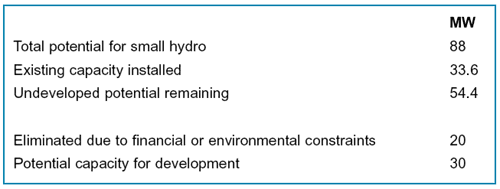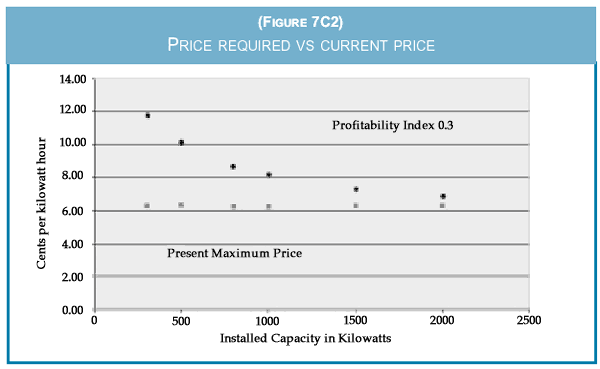
Ireland could almost double the amount of energy it is getting from small-scale hydro projects. Unfortunately, the real price being paid for hydro power has been falling for over twenty years and would need to rise to make investment attractive.
The term "small hydro" in this paper refers to
hydro power projects of less than 10 MW electrical
output. Before 1984 there were 20 MW of
small hydro capacity owned by the ESB in
Ireland, and less than 2 MW in private ownership.
In 1984 a comprehensive survey of hydro
power potential in the Republic of Ireland was
published. The survey identified a resource of
48 MW of low head small hydro and 40 MW of
high head small hydro in remote areas, giving a
total small hydro resource of 88 MW. Since
1984, 5 MW of low head potential and 6.6 MW
of the high head potential have been developed.
The total installed capacity of small hydro
power projects in the Republic of Ireland at
present is therefore 33.6 MW (22 MW installed
pre 1984 and 11.6 MW installed post 1984).
The capacity of small hydro power remaining to
be developed is estimated in the table below.

Of course there are also environmental and/or financial constraints surrounding the development of even the 30 MW of potential capacity. There are concerns about the potential environmental impacts on fish life, for example, although there can be a difference between the perceived environmental impacts of a potential small hydro power project and the impacts in reality when proper design and impact mitigation measures are implemented. The EU Water Framework Directive (Directive 2000/60/EC) is now a relevant part of the policy context of small hydro. It states that "Further integration of protection and sustainable management of water into other Community policy areas such as energy, transport, agriculture, fisheries, regional policy and tourism is necessary."
Though it would appear that as long as there is no significant impoundment by small hydro, the Directive is much more concerned with the pollution caused by industry, domestic sewage and agriculture.
There are also financial constraints to the development of the small hydro capacity in terms of the price available for the electricity produced. The principal options used by hydro power generators in the Republic of Ireland to sell their electricity to date are:
Prices paid to renewable suppliers who do not have a power purchase agreement are based on ESB's avoided fuel cost. This option is only suitable to provide additional income for projects where the main objective is self-supply.
The principal mechanism at present for supporting the development of small hydro projects is the Alternative Energy Requirement (AER) scheme run by the Department of Communications, Marine and Natural Resources, the government department with responsibility for energy. The AER provides successful bidders with a long-term Power Purchase Agreement (PPA) under which electricity is sold to the ESB. The Department is responsible for setting the cap prices and the amount of capacity offered under each round of the competition. The first round of the AER was held in 1994. Before then contracts were negotiated by project developers directly with the ESB although the price paid was common to all small hydro supplied and was set by the government.
The lower line in the graph below (Figure 7C1)
shows the purchase price for small hydro production
from 1981 to 2002.

The price payable if the 1981 price had been fully index-linked is shown by the upper line. The price in 1981 was based on avoided fuel cost plus a bonus for regular winter supply. In 1991, an agreement was reached between the Irish Hydro Power Association and the Department of Energy which based the price on ESB avoided fuel cost, operating cost, avoided transmission losses and a small premium for being green.
In the rapid and successful development of wind power in certain EU countries, political price has been a clear winner over political quota. Central to this has been the recognition that the generator must be allowed to make a profit to compare with alternative investments. The concept of a "Profitability Index" is being used increasingly as a basis for tariff structures. The development and the sustaining of small hydro in Ireland could benefit greatly from this approach.
To calculate a Profitability Index, data on the following parameters is required:
The Profitability Index is then calculated as follows:
Present Value = Cash Flow discounted over 15
years at 6.5% (or other rate)
Net Present Value = Present Value - Investment
cost
Profitability Index = Net Present Value/Investment Cost
Figure 7C2 below shows the price required at
50% overall hydro plant efficiency to achieve a
profitability index of 0.3 (upper series of data
points).

This 0.3 index is considered to provide a reasonable return to the project developer. The smaller the installed capacity of the hydro power project, the higher the electricity sale price that is required to maintain an index of 0.3. Figure 7C2 also shows the maximum price that is presently available under the AER (lower series of data points). It is clear that the present maximum price available under the AER is not sufficient for small hydro projects to make a reasonable profit on the investment required. It is concluded therefore that improved government policy is required to assist in the development of the remaining small hydro potential in the Republic of Ireland.
The Irish Hydro Power Association is the representative body for the operators of small hydro power projects in Ireland. It is affiliated to the European Small Hydropower Association (ESHA). The ESHA website (www.esha.be) provides much useful information on renewable electricity generation from small hydro power projects.
The IHPA may be contacted by telephone at 0902 57660.
This is one of almost 50
chapters and articles in the 336-page large format book, Before the Wells
Run Dry. Copies of the book are available for £9.95 from Green Books. Continue to part D of Section 7: Ireland's geothermal resources are ideal for space heating
